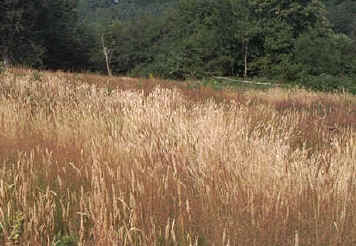The term 'meadow' is strictly speaking used to describe grass fields which are grown for hay. However many hay meadows will also be grazed at some point
and some fields which are predominantly used for grazing may also be cut for hay. For the purposes of these pages, a 'meadow' is taken to mean a small,
flower-rich, agricultural grassland which is not intensively managed. This blanket term
encompasses several different grassland types, which are distinguished by variations in
the specific composition of their plant communities. These differences in plant species
composition and hence grassland type, result from local variations in soil and climate.
However, all meadows, whatever their specific differences, share certain features in
common.
- Meadows are permanent pastures. Permanent
is taken to mean that they have not been ploughed within at least seven years. Indeed,
they may never have been ploughed in living memory. They are therefore relatively
undisturbed areas which have had time to develop complex ecosystems.
- They are pastures which are grazed at a low intensity and
or, used for haymaking. The grazing of small numbers of cattle or sheep
prevents scrub and woodland from growing up, without eliminating the more palatable plant
species by overgrazing. Low intensity grazing favours a diversity of plant species. It
continually creates more open areas for colonization by different plants and prevents
individual plant species from becoming dominant at the expense of others. Because they are
cut for hay, woody plant species such as bramble do not become established. This prevents
them from growing up and shading out the grasses and herbs.
- They have a low fertilizer input from the farmer who
manages them. They are unimproved grasslands. This means that they largely
consist of a mixture of grasses rather than the predominantly Perennial Ryegrass swards of
intensive grassland. This mixture will contain wild grasses. The meadow will have had a
small fertilizer input. This can be either artificial, or natural fertilizer i.e. dung or
slurry. The low input is crucial to the existence of meadows because most wild flowers are
adapted to relatively low soil nutrient levels. High soil nutrient levels from intensive
fertilization, favour a very few species which thrive under such conditions, at the
expense of all the rest.
- Meadows have a low output in terms of yield for the
farmer. The grass yields of meadows will nowhere near match those produced
from the ubiquitous, intensively managed grass fields which have largely replaced meadows.
Therefore, although meadows require less input from the farmer, they will also support far
fewer animals of real cash value than an intensively managed and productive grass field.
In contrast to meadows, intensively managed grass fields will have been heavily improved
with high fertilizer inputs. They will have been ploughed and seeded, usually with one or
two genetically improved high yielding grasses such as Perennial Rye Grass (PRG). Other
management techniques include spraying to kill unwanted plants such as docks. The grass
grown in this way, is a crop as much as any other. It is managed to produce the highest,
best quality yields possible, to feed as many animals as possible. After a few years the
crop yield may deteriorate for a number of reasons. It will then be ploughed again and
resown. This kind of intensive grass production leaves less room either for diversity, or
for wildlife. In contrast, meadows will be very infrequently ploughed. Some may not have
been ploughed in living memory. This means that the plant and animal communities have been
established over a long period of time.
- Meadows are small fields, generally found
on soils of lower fertility or where there is poor accessibility for machinery.
- Individual meadows tend to be a reasonably uniform
habitat overall, albeit one containing an amazing diversity of plant and
animal species.
 |
- Meadows are usually old landscape features
and as such are likely to be surrounded by similarly old boundaries such as species-rich
hedges, old stone walls or woodland. These further increase the wildlife diversity of the
meadows themselves, as invertebrates, birds and mammals living in these marginal habitats
spill over into the meadows in search of food.
|
- Hay meadows are cut late in the summer season.
If meadows are cut for hay, the grass is allowed to grow tall, flower and set seed before
it is actually cut. This gives animals, including ground nesting birds living in the
meadow, the time to rear their young before harvesting machinery removes their cover. It
also allows invertebrates such as butterflies time to complete important stages of their
life cycles. The flowers and seeds from the grasses and all the other plants in the meadow
also have time to grow and complete their lifecycle. This also provides food for
innumerable invertebrates, birds and small mammals.
Continue to:- Types of Meadow |

